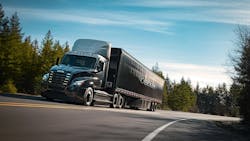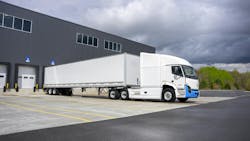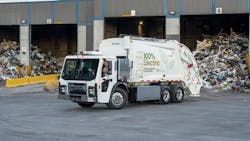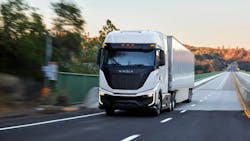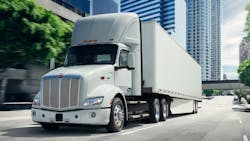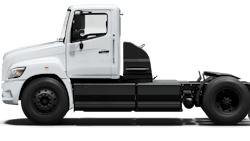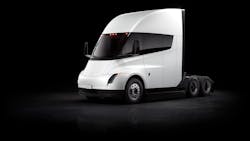2025 new models: Heavy-duty alternative fuel vehicles
The 2025 model year is punctuated by emerging technologies and innovations that bring those technologies to fleets. Nowhere else is that more noticeable than among heavy-duty vehicles with alternative powertrains.
Major OEM brands like Freightliner, Kenworth, Mack, Peterbilt, and Volvo have their own EV variants of popular truck models. Newer, growing companies like Nikola and Tesla boast highly competitive ranges and charge times.
Each truck takes a different approach to maximizing efficiency and range. Kenworth’s T680 FCEV and Nikola’s Tre embrace hydrogen fuel cells as a dense energy source. The Freightliner eCascadia, Lion8 tractor, Nikola Tre, Peterbilt 579EV, and Tern RC8 utilize electric axles to save space and enhance range.
See also: The major electric axles for commercial vehicles
This non-comprehensive look at 2025 Class 8 fleet vehicles is the third of a six-part series this week highlighting new and updated commercial and fleet vehicles of all sizes. This week, FleetOwner’s 2025 Fleet Vehicle Outlook features details gathered by our editors on dozens of new and updated vehicles, from pickup trucks and vans to work trucks and tractors. Our newsletters and free Members Only section offer the latest innovations from each manufacturer, highlighting key features and benefits to help you make informed decisions about your fleet investments.
Freightliner eCascadia
The battery-electric Freightliner eCascadia began production in 2022 and has logged more than 6 million real-world miles for U.S. fleets as of this summer. It is available in a 116-inch day cab.
The zero-emission Class 8 truck’s batteries can be recharged to 80% in as little as 90 minutes. Several battery and drive axle options are available: Tandem drive offers 425-470 hp and up to 220 miles on a full charge; single-drive features 320-395 hp with a standard driving range of 155 miles—or 230 miles with long-range option.
The Freightliner eCascadia comes standard with the Detroit Assurance suite of safety systems, including Active Brake Assist 5.
Proprietary power: Along with its medium-duty counterpart, the Freightliner eM2, the eCascadia features Daimler’s proprietary Detroit ePowertrain with Detroit eAxles and batteries that work together to create more efficiency.
Kenworth T680 FCEV
Kenworth integrated Toyota’s latest advancements in hydrogen fuel cell technology into its flagship T680 on-highway truck. The T680 FCEV is expected to go into serial production in 2025 to offer fleet customers a range up to 450 miles.
The T680 FCEV stores most of its energy onboard as compressed hydrogen gas, allowing for smaller batteries and reducing the tractor’s weight. The truck is equipped with a 310 kW Dual Motor Assembly, capable of providing 415 hp continuously at a maximum 82,000-lb. GCWR, and the Toyota Gen 2 Dual Fuel Cell Module.
With top speeds of 70 mph, the vehicle can refuel its 58.8-kg capacity hydrogen tanks in a time similar to diesel operations.
Lion Electric Lion8 Tractor
The electric Lion8 Tractor, a Class 8 BEV from the Lion Electric Co., features a 127,000-lb. GCWR, which the OEM said is the highest of any commercial EV.
Lion’s heavy-duty battery packs feature 630 kWh capacity, providing up to 275 miles in range. The batteries can recharge to 80% in approximately 1.5 hours.
Featuring a 6x4 axle configuration, the Lion8 has two integrated 2-speed eAxles and a cab-forward design to improve driver visibility and maneuverability.
The tractor also features a high-energy-density proprietary 750V battery system and its standard vehicle-to-grid compatibility. Additional features include ADAS technology and an onboard weighing system, which the company said enhances safety and operational efficiency.
Mack LR Electric
The Mack LR Electric is a Class 8 clean vehicle built for dirty jobs of refuse and recycling applications in urban environments. The LR Electric’s powerful electric drivetrain delivers the torque and performance needed for frequent stops and starts, heavy loads, and varied terrain.
The LR Electric features a standard 376 kWh total battery capacity for increased range. With twin electric motors, the LR Electric offers 448 continuous horsepower and 4,051 lb.-ft. of peak output torque from 0 rpm.
The LR Electric has a 2-speed Mack Powershift transmission, Mack mRide suspension, and Mack’s proprietary S462R 46,000-lb. rear axles. The advanced battery technology and regenerative braking system maximize range and efficiency, ensuring the truck can handle long shifts.
Better routing: Mack said its team analyzes fleet customers’ routes and infrastructure to simplify EV integration into operations.
Nikola Tre FCEV
Nikola’s hydrogen fuel cell electric vehicle, the Class 8 Tre FCEV, features a range of up to 500 miles and an estimated refueling time as low as 20 minutes.
The company believes its truck is among the longest ranges of all commercially available zero-emission Class 8 trucks, with versatile applications ranging from drayage and intermodal to metro-regional truckload and less-than-truckload to certain specialized hauling use cases.
Through its advanced in-cab interfaces, drivers can optimize travel time, track fuel usage, and monitor vehicle systems. Nikola’s bespoke navigation system designed for the Tre FCEV integrates route planning that accounts for trailer dimensions and hazmat classifications. The Tre’s electronic steering and cabover design aims to improve maneuverability and navigation through tight spaces.
The Nikola Tre eAxle technology is purpose-built for heavy-duty applications to provide power and performance.
New safety ecosystem: The Nikola Tre FCEV’s advanced safety systems include lane departure warning, advanced emergency braking, and front and rear cameras. Nikola also developed its own ecosystem of distinct visual and audible alerts to keep drivers focused on the road.
Peterbilt 579EV
Designed for optimal weight distribution and performance, the fully integrated, all-electric Class 8 Peterbilt Model 579EV powertrain offers a 150-mile range on a full charge. When used in conjunction with a recommended DC fast-charger, the high-energy density battery packs recharge in three to four hours.
The Model 579EV is ideal for regional haul and drayage applications, in part because the frequent starts and stops engage the regenerative braking, which transfers energy back into the battery backs, reducing brake pad wear and extending operating range.
The e-axles are outfitted with 2-speed gearing and a 2:1 gearing reduction for great startability and efficient cruising. The Model 579EV uses an enhanced gauge cluster to clearly communicate all the information required for the driver to operate the electric vehicle, including power output, charge level, coolant temperature, service indicators, and more.
Brake benefits: Regenerative braking is controlled via the right-hand stalk and can be dialed into three distinct settings based on load and road conditions.
Tern RC8
The Tern RC8, which combines Hexagon Purus zero-emission technology with Hino Trucks’ heavy-duty chassis, is expected to begin serial production by 2025.
The Class 8 electric tractor is based on Hino’s XL Series 4x2 chassis with a Hexagon Purus zero-emission powertrain and Dana e-Axle. The electric truck features a 165-inch wheelbase and 68,000-lb. GVWR.
The company said the RC8 is designed for regional urban duty cycles operating within 200 miles. The truck’s dual Hexagon Purus Gen3 269 kWh battery features a 750V, 538 kWh configuration. The truck offers peak 680 hp and continuous 494 hp and peak torque of 38,350 ft.-lb.
Dealer network: Tern trucks will be exclusively available through select Hino dealers, leveraging Hino Trucks' infrastructure and customer support.
Tesla Semi
Tesla claims the Class 8 Semi can travel between 300 and 500 miles per charge when loaded to 82,000 lb. GVWR.
The OEM also lists the energy consumption of the Semi as "less than 2 kWh/mile." Because of its sleek contours, the Semi will be less affected by drag at highway speeds, with a drag coefficient of 0.36, or about half that of a conventional diesel Class 8 vehicle, according to Tesla.
The Semi comes standard with active safety features that pair with advanced motor and brake controls to deliver traction and stability. A central seating position gives the driver better visibility, while an all-electric architecture reduces both rollover risk and cabin intrusion in case of an accident.
Burn rubber: Three independent Tesla motors provide instant torque and power at any speed. The Semi can accelerate from 0-60 mph in 20 seconds when fully loaded and maintain highway-level speeds up steep grades, according to Tesla.
Volvo VNL Electric
Volvo Trucks North America was the first legacy heavy-duty OEM to begin serial production of a Class 8 EV earlier this decade with the VNR Electric, designed for regional and short-haul operations. The global truckmaker teased plans earlier this year for its second electric heavy-duty, the VNL electric.
Volvo said the brand could begin selling the new Class 8 electric truck in late 2025. Just like the VNR Electric was modeled after the diesel-powered VNR tractor, the VNL Electric is based on the all-new ICE-powered Volvo VNL that debuts this year. Volvo announced in June that the VNL Electric will be the "flagship of North America's best-selling line of heavy-duty battery electric trucks.”
About 1,000 VNR Electric trucks are currently operating in the U.S. and Canada, giving Volvo more than 40% market share of over-the-road heavy-duty electric trucks. The OEM said the VNR Electric will remain available until the VNL Electric debuts.
Electrifying the future: VTNA is ramping up its EV-certified dealership network in North America to support the VNR Electric and future VNL Electric. And the OEM now has a better business after acquiring Proterra earlier this year.
About the Author
FleetOwner Staff
Our Editorial Team
Kevin Jones, Editorial Director, Commercial Vehicle Group
Josh Fisher, Editor-in-Chief
Jade Brasher, Senior Editor
Jeremy Wolfe, Editor
Jenna Hume, Digital Editor
Eric Van Egeren, Art Director
